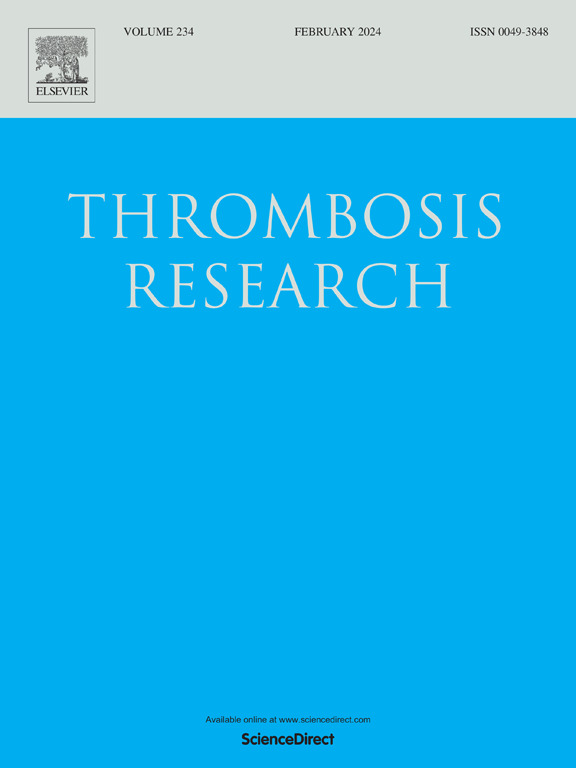All-cause mortality after major gastrointestinal bleeding among patients receiving direct oral anticoagulants: a systematic review and meta-analysis
IF 3.4
3区 医学
Q1 HEMATOLOGY
引用次数: 0
Abstract
Background
Although gastrointestinal (GI) bleeding represents the single most frequent site of anticoagulant-related major bleeding, outcomes after major GI bleeding including mortality are not well characterized and severity may be underappreciated. We aimed to determine 30-day all-cause mortality in adults with major GI bleeding on a direct oral anticoagulant (DOAC).
Methods
We searched MEDLINE, EMBASE, and Cochrane CENTRAL from inception to May 9, 2024 for randomized controlled trials and cohort studies that reported 30-day all-cause mortality after major GI bleeding in adults treated with a DOAC for venous thromboembolism or atrial fibrillation. Risk of bias was assessed using a modified QUIPS tool for prognostic studies. 30-day all-cause mortality was calculated using the random-effects inverse-variance method.
Results
We included 20 studies comprising 3987 DOAC-treated patients with major GI bleeds. The pooled estimate of 30-day all-cause mortality was 8.4 % (95 % confidence interval [CI], 4.9–12.5; I2 = 83 %). In subgroup analyses, 30-day all-cause mortality was 10.3 % (95 % CI, 6.5–14.7; I2 = 24 %) in prospective studies (9 studies, 675 major GI bleeds), 7.3 % (95 % CI, 2.2–14.4; I2 = 90 %) in retrospective studies (11 studies, 3312 major GI bleeds), 12.9 % (95 % CI, 6.3–21.1; I2 = 44 %) in considered at high risk of bias (9 studies, 387 major GI bleeds), and 6.1 % (95 % CI, 2.9–10.1; I2 = 89 %) in those at low risk of bias (10 studies, 3562 major GI bleeds).
Conclusion
DOAC-related major GI bleeding appears to be associated with significant 30-day all-cause mortality. Further research is needed regarding the causes and contributors to mortality in this population to identify patients at high risk and develop mitigation strategies.
接受直接口服抗凝剂治疗的患者发生消化道大出血后的全因死亡率:一项系统回顾和荟萃分析
背景:虽然胃肠道出血是抗凝相关大出血的最常见部位,但胃肠道大出血后的结果(包括死亡率)尚未得到很好的描述,严重程度可能被低估。我们的目的是确定使用直接口服抗凝剂(DOAC)的严重胃肠道出血成人30天的全因死亡率。方法:我们检索MEDLINE、EMBASE和Cochrane CENTRAL从成立到2024年5月9日的随机对照试验和队列研究,这些研究报告了成人静脉血栓栓塞或房颤DOAC治疗后大出血后30天的全因死亡率。使用改进的QUIPS工具评估预后研究的偏倚风险。采用随机效应反方差法计算30天全因死亡率。结果我们纳入了20项研究,包括3987例经doac治疗的严重消化道出血患者。30天全因死亡率的汇总估计值为8.4%(95%可信区间[CI], 4.9-12.5;i2 = 83%)。在亚组分析中,30天全因死亡率为10.3% (95% CI, 6.5-14.7;在前瞻性研究(9项研究,675例主要胃肠道出血)中I2 = 24%, 7.3% (95% CI, 2.2-14.4;I2 = 90%),在回顾性研究中(11项研究,3312例主要胃肠道出血),12.9% (95% CI, 6.3-21.1;I2 = 44%)被认为是高偏倚风险(9项研究,387例主要胃肠道出血),6.1% (95% CI, 2.9-10.1;I2 = 89%),在低偏倚风险组(10项研究,3562例主要胃肠道出血)。结论doac相关性大出血与30天全因死亡率显著相关。需要进一步研究导致这一人群死亡的原因和因素,以确定高危患者并制定缓解战略。
本文章由计算机程序翻译,如有差异,请以英文原文为准。
求助全文
约1分钟内获得全文
求助全文
来源期刊

Thrombosis research
医学-外周血管病
CiteScore
14.60
自引率
4.00%
发文量
364
审稿时长
31 days
期刊介绍:
Thrombosis Research is an international journal dedicated to the swift dissemination of new information on thrombosis, hemostasis, and vascular biology, aimed at advancing both science and clinical care. The journal publishes peer-reviewed original research, reviews, editorials, opinions, and critiques, covering both basic and clinical studies. Priority is given to research that promises novel approaches in the diagnosis, therapy, prognosis, and prevention of thrombotic and hemorrhagic diseases.
 求助内容:
求助内容: 应助结果提醒方式:
应助结果提醒方式:


